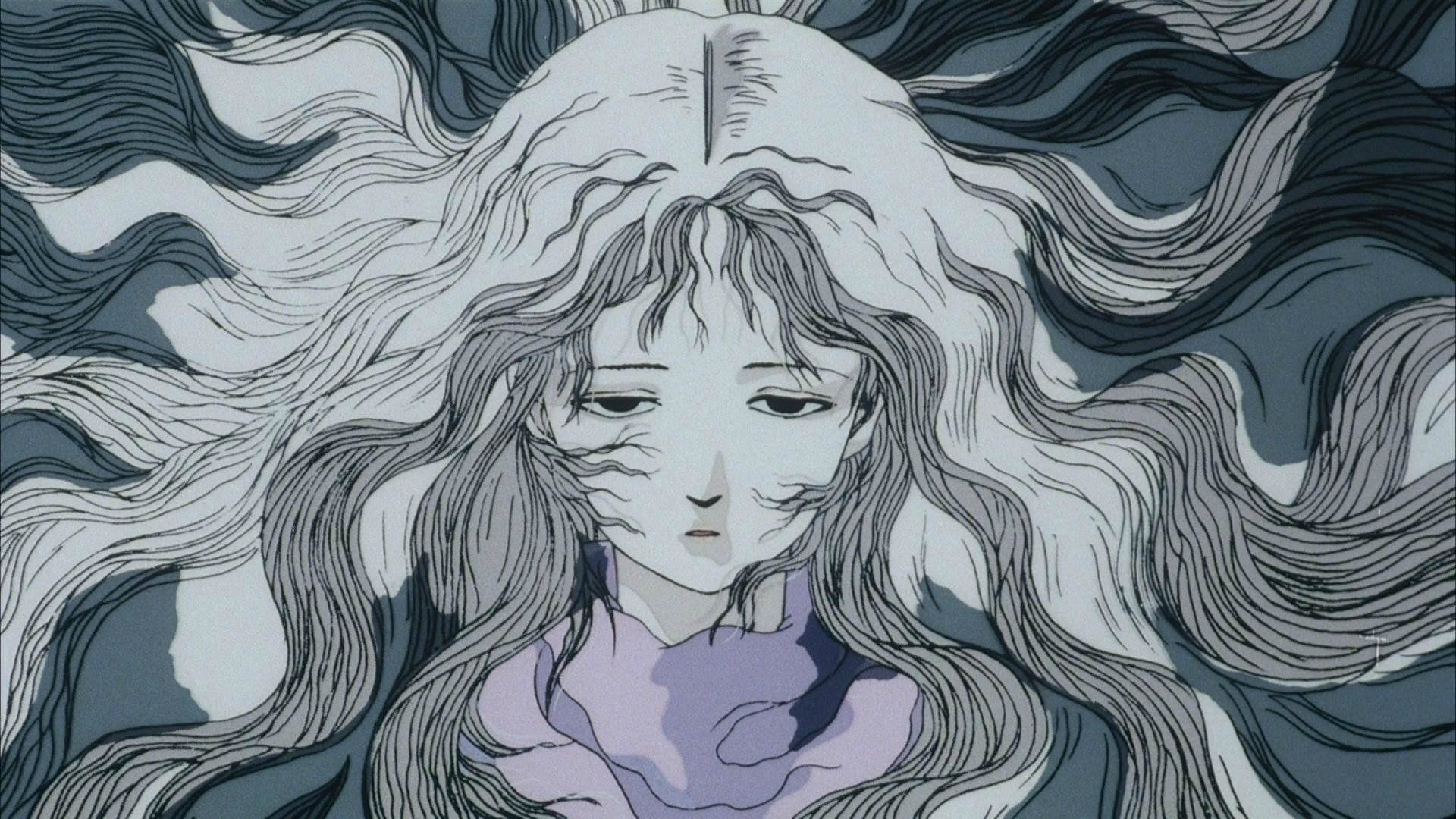How the Haunting and Mysterious Angel’s Egg Influenced Video Games
This masterpiece’s environmental storytelling has cast a long shadow

There is a moment during the runtime of Angel’s Egg when I feel as though I’m revisiting a place I’ve never been. It’s subtle. As the girl (unnamed, barefoot, hair wild as a nimbus) treks her way across the Art Nouveau cityscape, scavenging for water and food, I visualize other experiences. I am crawling the streets of Yharnam in Bloodborne. I am descending the Hollownest in Hollow Knight. I am approaching the end of the world in Dark Souls III. Armed with little more than her wits in a crumbling world, the unnamed girl perseveres despite the overwhelmingly dire circumstances that permeate a destroyed landscape.
The city is one that numerous gamers have traversed before.

A Ruin We Know
Thirty-six years ago, Yoshitaka Amano artistically dictated a veritable masterpiece that was not Final Fantasy. Predating the renowned series by nearly two years, Amano lent his dreamlike artistic talents to Mamoru Oshii’s non-commercial piece of animated wonder, Angel’s Egg. Built upon a threadbare plot and set in a world unfettered by narrative expectations, Angel’s Egg has endured its nearly forty-year existence as a piece of moving art, an unstructured Neo-Gothic entry in a canon where it will never enjoy the success of titles such as Spirited Away. Another decade passed before Oshii would cement himself as a celebrated auteur with the release of Ghost in the Shell, and Angel’s Egg may never enjoy mainstream praise outside of an eccentric curiosity.
Despite this, it is difficult to ignore its outstanding influence.
Video games, especially Japanese RPGs, have inspirations firmly rooted in anime. The Final Fantasy series can trace its roots to the likes of Nausicaä of the Valley of the Wind and Castle in the Sky, and common anime tropes and stereotypes can be seen in everything from Pokémon to Metal Gear Solid. Where many games might proudly wear their inspirations, Angel’s Egg and its umbrella of non-linear storytelling and impressive world building are more difficult to trace — still, any discerning fan cannot witness this classic film without drawing parallels to Dark Souls or Castlevania.

A Story Built By A World
Non-linear, environmental storytelling is fairly new in contemporary popular fiction, and the Dark Souls series has been instrumental in its application of this abstract approach. It is easy to watch Angel’s Egg and come away with a sense of confusion and a lack of understanding. It is a film that has no interest in explaining itself — it is a “vibe” so to speak, an artistic endeavor crafted to garnish audience reaction and discussion. What was in the egg? Where did the girl come from? Who was the boy? What is this strange society of bio-mechanical entities and what is all this talk of angels and floods?
It’s common to play a FromSoftware title and come away with an overwhelming sense of confusion. Though games like Bloodborne and Dark Souls are filled with bombastic bosses and decrepit areas that warrant tedious exploration, their actual storylines are open to broad interpretation, their creator Hidetaka Miyazaki leaving the most important aspects of their narratives dark so that audiences can glean their own takeaways from its mysterious environs. It’s the “vibe” that matters here, the pull is both emotional and visceral, as the city streets befallen with plague and ruin spark intense imaginative reactions. This is where Angel’s Egg showcases its beating heart, its world an ark of Gothic ruin that heralds a society whose details we will never know.
I am an enormous fan of these sorts of titles, not specifically for the difficulty they present but for their enduring imaginative challenge. Any video game whose story is forwarded by the environment becomes a classic in more ways than one — their storyline is discussed in broad detail across fan interaction, YouTube essays, articles and books, this sort of piecemeal mystery echoing a basic human curiosity. In the recent ENDER LILIES: Quietus of the Knights, snapshots of a verdure kingdom are granted as temporary respite from the deluge of dark rain that drowns a fungal landscape. Ender Lilies had me considering Angel’s Egg, as both titles task a pale snow-haired waif with an uncertain future among a society post-ruin.

Drawing Parallels
In 2017, the prominent YouTube essayist VaatiVidya recounted the similarities between Dark Souls III and Angel’s Egg in this stunning video, proffering a loose connection between the game’s final DLC and the film’s lingering mystery. The faith the girl has in the egg — the faith that garnishes what might lay inside it— is akin to the experiences we imprint upon games whose designs are open to interpretation, each one of us heralding vastly different experiences in what we take away from these loose narratives. What moves me through Dark Souls or Hollow Knight or Castlevania does not rest solely with the general gameplay but is fostered by the mysterious nature of these worlds.
When it comes to enjoying our favorite pieces of media, it’s easy to see the through-line of influence, whether it’s Star Wars into Final Fantasy or Berserk into Dark Souls. Angel’s Egg exists as a striking metric, where the takeaway of the film is this dreamy recollection. Authorial intent and inspiration lives in the subconscious, and when designing new works we pull from the entire library of our personal experiences. Whether it’s Hideo Kojima’s cinephile influences or Disco Elysium bearing inspiration from True Detective, works that cross mediums gain a meatiness that can be felt by a variety of audiences.
Angel’s Egg, despite all this interpreted influence, is rarely touted as inspiration, though a quick Google search showcases a bevy of curious fans who wonder what the masterpiece has actually influenced, from Dark Souls to Death Stranding. The fan belief of its enduring impact is as abstract as the stories presented in these games.

A Quiet Legacy
We may never learn more about the world of Angel’s Egg. Like Dark Souls, the information provided outside of the work is minimal, and even the most ardent fan can be stymied by their appreciation of what the work is “actually” about. Hidetaka Miyazaki’s own employees have admitted they have no idea what Dark Souls is about, which only adds to the mystery. Like the girl trucking the mysterious egg through the ruined city, we carry our gentle love of these video games with us because we wish to protect our fervent belief over what they really are.
Though Angel’s Egg might hold an influence that is as imaginary and frustrating as the film itself, I cannot help but see its landscape in these video games, their stylistic renderings and haunting worlds existing like reflections in the pools of rain that litter the city streets of this anime classic.
Ultimately I am haunted by the parallels, left wondering what influences are intentional and which are my fervent hope.
“I have a feeling that I’m creating a story which, if left alone, is gradually absorbed into classics. The image of the movie was that of something pure coming out of an actually much more suspicious world filled with dubious nothings. Gradually, it was purified into an ‘art film’. I didn’t think it would become a purified world but what had been done so far strangely enough has the ‘face of a classic’. While making this film, I ended up thinking I was forging a classic.”
Mamoru Oshii on Angel’s Egg
